S

French scientist, author, lawyer, philosopher, educator, poet – Stamp: Netherlands B127

Russian, author, journalist, mathematician, educator, astronomer, professor, geophysicist, and Arctic explorer. Born in Mogilev on September 30, 1891, he was educated at the University of Kiev, where he graduated in 1913. He was an associate professor of mathematics at his alma mater from 1918 to 1920. After the Revolution, he joined the Communist Party in 1918. After holding a number of senior civil service posts in various commissariats, he became the Head of the State Publishing House (Gosizdat), 1921-1924 and following that he was the Head of the Central Statistical Administration (Tsentral'noye Statisticheskoye Upravleniye), and a member of the State Planing Commission (Gosplan). During this same period he was a professor at the Moscow Forestry Institute; and from 1926 until his death he taught at Moscow University. A keen climber with an interest in glaciology, in 1929 he made his first Arctic expedition to Zemlya Frantsa-Iosifa (Franz Josef Land) and he navigated the western coast of Severnaya Zemlya. During the course of his expedition, one of the islands that he discovered was named after him. In the next year he became the Director of the Arctic Institute, becoming an Academician in 1932. In that same year he became the Head of the newly-formed government department created to develop the Arctic, the Chief Administration of the Northern Route (Glavsevmorput'). After that he was to lead a number of expeditions: on board the icebreaker Sibiryakov (1932), which was he first ship tht sailed non-stop from Arkhangel'sk to the Pacific Ocean; and the ill-fated Chelyuskin expedition, 1933, which attempted a non-stop cruise along the Great Northern Sea Route. In 1938 he became the Director of the Institute of Theoretical Geophysics (now the Geophysical Institute of the Akademiya Nauk SSSR). In one of the government purges he was dismissed from the Northern Sea Route Administration in 1939, but he was fortunate to be able to carry on with his scientific pursuits, most notably his chief editorship (1924-1941 of the Bol'shaya Sovetskaya Entsikopediya (Great Soviet Encyclopedia). The founder of the Moscow school of algebra, he turned his attention to problems of geophysics and astronomy. His publications include Abstraktnaya teoriya grupp (The Abstract Theory of Groups, 1914); Beskonechnyye razreshimyye gruppy (Infinite Solvable Groups, 1945); Astronomicheskiy vozrast Zemli (The Astronomical Age of the Earth, 1945); O zakone planetnykh rasstoyaniy (The Law of Planetary Distances, 1946); and Vozniknoveniye planet i ikh sputnikov (The Origin of the Planets and Their Satellites, 1950). He died on September 7, 1956.- Russia 3191A; 4885; C59

Schwarz wrote a thesis on reducibility of polynomials over finite fields, which should explain the lattice in the middle [his supervisor was Karel Petr]. Schwarz most important work was in semigroup theory. In this stamp he is with Jurai Hronec.

Segner was a physician, author, physicist, mathematician, educator, inventor. Born on October 9, 1704 in Pressburg, Hungary (now Bratislava, Czechoslovakia), he was educated in the Gymnasiums of Pressburg and Debrecen and then at the University of Jena, 1725-1730, where he studied medicine and theology and where he received his M.D. He returned home and immediately established his medical practice in Pressburg. He next accepted the post of medical director for the city of Debrecen. But he left his post there in 1732 and returned to Jena to study mathematics. In 1733 he was appointed by the Duke of Weimar to a chair in mathematics at the University of Jena. In 1735 he was named ordinary professor of mathematics and physics at the University of Gottingen and he remained there until 1755 when he took the same chair at the University of Halle. He remained there until his death in Halle on October 5, 1777. He invented the first reaction hydraulic turbine which was named after him, the so-called Segner wheel. He defended Newton's theory of the emanation of light in 1740 and in the field of mathematical logic he developed Leibniz's ideas.
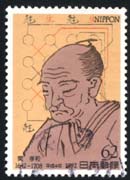
4.11.1992, Men of Culture
Born into a samurai warrior family, Seki derives from the noble family who adopted him, an infant prodigy in mathematics, self-educated in mathematics, known as 'The Arithmetical Sage', a term which is carved on his tombstone
Publications Hatubi Sanpo
Biography
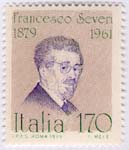
Severi's most important contributions are to algebraic geometry, work on enumerative geometry and birational geometry of surfaces
Biography

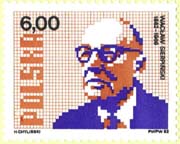

Biography
Waclaw Sierpinski (1882-1969), a Polish mathematician working in number theory and set theory, described the self-repeating, or fractal design. Sierpinski triangles are created by connecting the the midpoints of the sides of a triangle to form four smaller, interior triangles, and then repeating this process for each of the outside three triangles, ad infinitum. An example using a pyramid instead a triangle is shown on the right stamp.
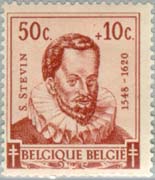
In 1586, Simon Stevin began a book on statics and hydrostatics, De Beghinselen der Weeghconst, with the assumption that perpetual motion was impossible and that therefore any given mass of water was in equilibrium in all its parts. On this basis, he concluded that the pressure of a liquid on the base of a container depended only on depth. He also demonstrated that the center of gravity of a triangle lies on its median. He demonstrated the same for parabolic segments.
Biography

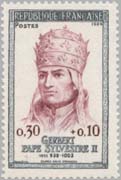
France 1964, Michel 1479, Scott B384
Bishop of Rheims (991-95). Bishop of Ravenna (998-99). Roman Catholic Pope (999-1003) Sylvester II was the first pope of the eleventh century and also the first French pope. He was famous for his learning, especially in mathematics and the sciences, and was the personal tutor of Emperor Otto III. Sylvester was one of the first European adopters of the system of Arabic numerals, which he presumably learned from the study of Arabic texts during his youth as a student in Spain.
R - S - T











